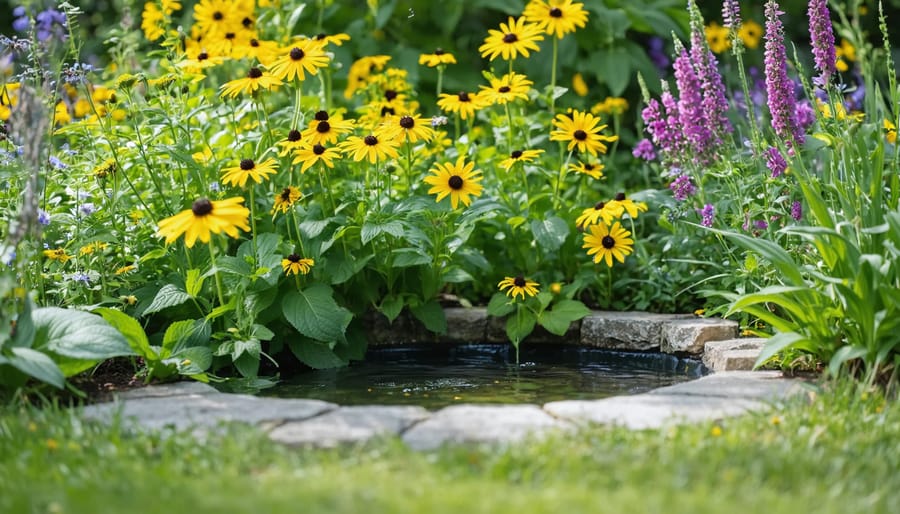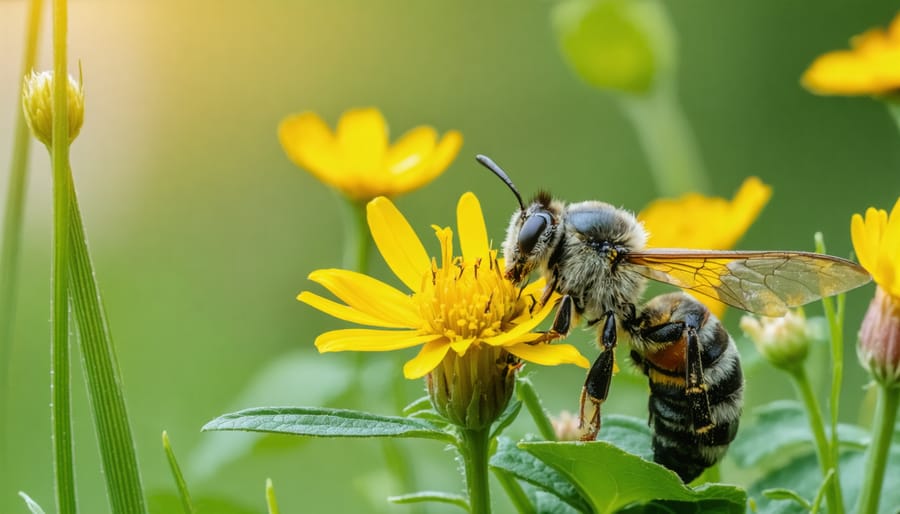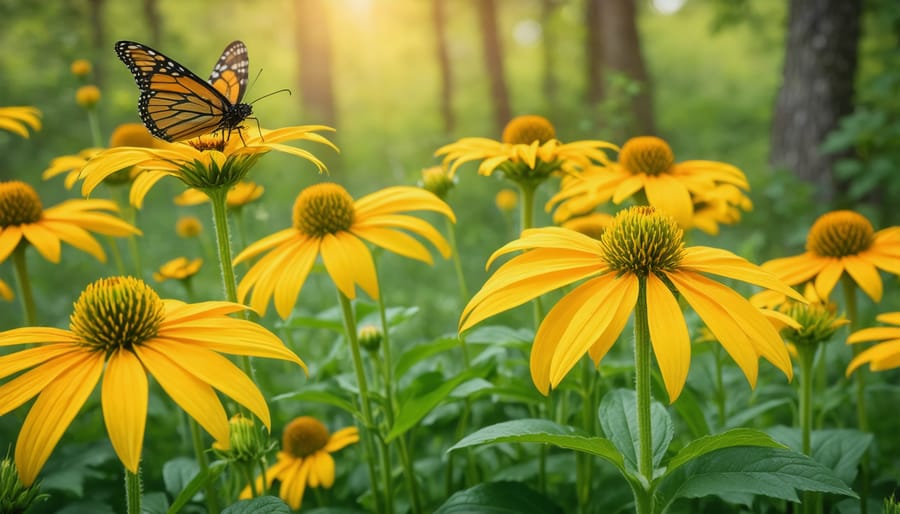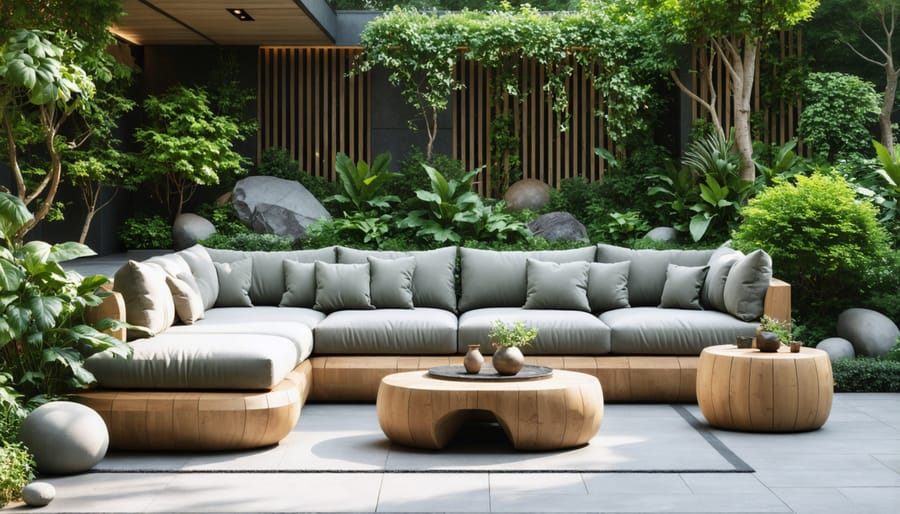Transform Your Backyard Into a Buzzing Paradise: A Small Pollinator Garden That Works

Transform your compact outdoor space into a vibrant pollinator haven by designing strategic planting zones that maximize nectar sources in as little as 50 square feet. Group native flowering plants in clusters of 3-5 specimens to create visible “landing pads” that attract bees, butterflies, and hummingbirds. Install vertical growing elements like trellises and wall-mounted planters to double your garden’s pollinator-supporting capacity without expanding its footprint.
Master the essentials of pollinator-friendly landscaping basics by incorporating flowers of varying heights, shapes, and blooming periods to ensure continuous food sources from spring through fall. Position taller plants like native coneflowers and salvias at the back, medium-height black-eyed Susans in the middle, and compact herbs like oregano and thyme along borders. Include a small water source – even a shallow dish with pebbles – to provide essential hydration for pollinators while maintaining your garden’s space-efficient design.
Layer your plantings with early, mid, and late-season bloomers to create a sustained buffet for beneficial insects throughout the growing season, all while keeping maintenance requirements manageable in your limited space.
Planning Your Small-Space Pollinator Haven
Choosing the Perfect Location
Selecting the right location for your pollinator garden is crucial for both plant success and your enjoyment. Start by identifying areas that receive at least 6 hours of sunlight daily, as most flowering plants thrive in full sun. However, if your space is partially shaded, don’t worry – there are plenty of pollinator-friendly plants that can adapt to these conditions.
Consider placing your garden where you can easily observe it from your patio, deck, or kitchen window. This not only adds visual interest to your outdoor living space but also allows you to enjoy watching butterflies, bees, and hummingbirds at work. Easy access to a water source is essential, so choose a spot near an outdoor faucet or within reach of your garden hose.
Pay attention to natural wind patterns in your yard, as pollinators prefer calm areas where they can easily land on flowers. If possible, position your garden near existing structures like fences or shrubs that can provide shelter from strong winds. Also, ensure the location doesn’t collect standing water, which can harm plant roots and create unfavorable conditions for both plants and pollinators.
Space-Smart Design Principles
Making the most of limited space requires clever design strategies that maximize every inch of your garden. Start by exploring vertical gardening solutions like wall-mounted planters, trellises, and hanging baskets to create layers of pollinator-friendly plants. Stack containers at varying heights using sturdy shelving or tiered plant stands to add depth and interest while accommodating more plants.
Consider multi-functional elements like climbing vines that provide both vertical interest and nectar sources. Group plants with similar water needs in the same containers to simplify maintenance, and choose compact varieties bred specifically for small spaces. Place taller plants and structures against walls or fences to create a backdrop while leaving open areas for smaller, low-growing species.
Strategic plant placement is crucial – position nectar-rich flowers where they’ll receive appropriate sunlight and arrange them in clusters to make it easier for pollinators to find them. Create paths between plant groupings that allow easy access for maintenance while maintaining a cozy, garden-room feel. Remember to include a small water source, which can be as simple as a shallow dish with pebbles, to support your garden’s pollinators.

Best Plants for Small Pollinator Gardens
Spring Bloomers
Early spring brings the first stirrings of pollinator activity, and your garden should be ready to welcome these essential visitors. Start with hardy crocus varieties, which often push through late snow to provide early nectar sources. These are followed by cheerful daffodils and grape hyacinths, creating layers of color and feeding opportunities for emerging bees.
Plant clusters of spring-blooming natives like Virginia bluebells and wild columbine, which are perfectly adapted to support local pollinator populations. Pussy willows serve double duty, offering both early pollen sources and attractive garden structure. Don’t forget the powerhouse duo of bleeding hearts and lungwort, which thrive in partially shaded spots and attract early-season butterflies.
For sunny areas, consider adding compact varieties of flowering quince or dwarf fruit trees. These not only provide essential early-season food for pollinators but also create vertical interest in your small garden space. Edge your garden with low-growing creeping phlox, which creates a colorful carpet while providing landing spots for tired bees making their first flights of the season.
Summer Stars
During peak summer months, your pollinator garden should burst with vibrant, nectar-rich blooms that attract a diverse array of beneficial insects. Coneflowers (Echinacea) serve as sturdy anchors, their long-lasting purple and pink blooms drawing butterflies and bees from June through September. Black-eyed Susans offer cheerful yellow flowers that complement coneflowers perfectly while providing essential pollen sources for native bees.
Include butterfly weed (Asclepias tuberosa) for its clusters of orange flowers that monarch butterflies find irresistible. Bee balm adds height and striking red or purple blooms that hummingbirds can’t resist, while compact varieties of garden phlox provide sweet nectar for moths and butterflies. Consider adding shorter varieties of blazing star (Liatris) for their distinctive purple spikes that attract both butterflies and beneficial wasps.
For continuous blooming, stagger your plantings so that as one variety begins to fade, another takes center stage. Group these summer stars in clusters of three to five plants to create visible landing pads for pollinators and maximize their visual impact in your small garden space.

Fall Favorites
As autumn approaches, your pollinator garden can provide crucial support for late-season visitors. Asters and goldenrod are absolute must-haves, offering rich nectar sources for butterflies and bees preparing for winter. New England asters, with their vibrant purple blooms, pair beautifully with the bright yellow plumes of goldenrod, creating a stunning fall display while feeding numerous pollinators.
Consider adding sedum ‘Autumn Joy,’ whose pink flower heads gradually deepen to rusty red, attracting butterflies well into October. Late-blooming herbs like anise hyssop and Russian sage continue providing nectar when other plants have finished their season. Don’t forget about native sunflowers – their seeds become valuable food sources for birds during the colder months.
Leave some stems standing through winter, as many beneficial insects use them for shelter. Adding ornamental grasses like little bluestem not only provides winter interest but also creates protective habitat for overwintering pollinators. Remember to delay your garden cleanup until spring to help these helpful creatures survive the cold months ahead.
Container-Friendly Options
Creating a pollinator garden doesn’t require a large yard – containers offer an excellent solution for small spaces. Even a balcony or patio can become a haven for bees and butterflies with the right plant selection. Consider deep containers at least 12 inches wide for optimal root growth and moisture retention.
Compact flowering plants like dwarf butterfly bush, container-friendly lavender varieties, and compact coneflowers thrive in pots while attracting pollinators. Herbs such as oregano, thyme, and compact varieties of bee balm are also excellent choices that serve double duty as both pollinator attractants and kitchen herbs.
For vertical interest, try growing climbing nasturtiums or cardinal climbers on container trellises. Annual flowers like zinnias, cosmos, and compact marigolds work beautifully in containers and bloom throughout the season. Consider grouping containers at varying heights to create visual interest and maximize space.
Remember to ensure proper drainage in your containers and use high-quality potting soil. Place your container garden where it receives at least six hours of sunlight daily, and keep the soil consistently moist but not waterlogged.
Garden Maintenance Made Simple
Seasonal Care Calendar
Keep your pollinator garden thriving year-round with this simple maintenance schedule:
Spring (March-May):
Clear away winter debris and dead plant material in early March. Add fresh compost to beds and prepare soil for new plantings. Start sowing seeds indoors for summer-blooming plants. In April, begin planting frost-hardy perennials and gradually introduce tender plants as temperatures warm. May is ideal for adding summer-flowering bulbs and establishing butterfly-attracting annuals.
Summer (June-August):
Regular deadheading encourages continuous blooming. Water deeply during dry spells, preferably in early morning. Maintain a light layer of mulch to retain moisture and suppress weeds. Monitor for pest issues but avoid chemical pesticides that harm pollinators. Add support stakes for tall-growing plants as needed.
Fall (September-November):
Leave seed heads and stalks standing for winter wildlife habitat. Plant spring-blooming bulbs in October. Reduce watering as temperatures cool. Add fall-blooming plants like asters and goldenrod to extend the pollinator season. Collect seeds from favorite plants for next year.
Winter (December-February):
Avoid cutting back dead plant material until early spring to protect overwintering insects. Monitor winter-blooming plants like witch hazel. Plan next season’s additions and order seeds early. Use this time to clean and organize garden tools and prepare for spring renewal.
Water-Wise Strategies
Creating a thriving pollinator garden doesn’t mean excessive water usage. By implementing smart water-wise garden practices, you can maintain a beautiful habitat while conserving this precious resource.
Start by grouping plants with similar water needs together. This practice, known as hydrozoning, ensures efficient water distribution and prevents both over- and under-watering. Install a drip irrigation system or soaker hoses to deliver water directly to plant roots, minimizing waste through evaporation.
Mulching is your secret weapon in water conservation. Apply a 2-3 inch layer of organic mulch around your plants to retain moisture, regulate soil temperature, and suppress thirsty weeds. Choose materials like shredded bark, leaves, or straw that will gradually break down and enrich your soil.
Consider installing a rain barrel to capture roof runoff. This free water source is perfect for your pollinator garden and helps reduce your environmental impact. Position it near your garden for easy access, and use a watering can for precise application.
Water deeply but less frequently to encourage deep root growth. Early morning watering reduces evaporation and allows plants to dry before evening, preventing fungal issues. Monitor soil moisture by inserting your finger about an inch deep – if it feels dry, it’s time to water.
Adding Garden Storage Solutions
Stylish Tool Storage Options
A well-organized garden starts with smart storage solutions that blend seamlessly with your pollinator paradise. Organizing garden tools effectively not only makes maintenance easier but can also add visual interest to your garden space.
Consider repurposing vintage items as charming tool holders. An old wooden ladder can become a vertical storage solution for hanging trowels and pruners, while simultaneously serving as a stunning support for climbing plants like clematis or honeysuckle. Weather-resistant wicker baskets mounted on fence panels create accessible storage while maintaining a natural, rustic aesthetic.
For smaller spaces, opt for dual-purpose furniture pieces. A decorative bench with hidden storage underneath keeps your tools accessible while providing a peaceful spot to observe visiting pollinators. Wall-mounted tool racks can be disguised with climbing vines or decorative screens, maintaining the garden’s natural appeal while maximizing vertical storage space.
Choose storage solutions in materials and colors that complement your garden’s design theme. Copper or brass tool hooks develop a beautiful patina over time, while painted wooden tool caddies can match your garden color scheme. For moisture protection, incorporate weather-resistant storage boxes that double as attractive seating areas or plant stands.
Remember to position your storage solutions strategically near your working areas while ensuring they don’t obstruct the natural flight paths of your garden’s winged visitors.

Integrating Storage with Garden Features
In a small pollinator garden, every inch counts, and clever storage solutions can seamlessly blend with your garden features. Consider installing a bench with built-in storage underneath for gardening tools, making it both a comfortable seating area and a practical storage space. This dual-purpose approach helps maintain the garden’s aesthetic while keeping necessities close at hand.
Vertical planters with hidden compartments work wonderfully for storing smaller items like hand tools, plant markers, and gloves. You can create tiered planter boxes with pull-out drawers at the base, perfect for housing supplies while supporting climbing pollinator-friendly plants above.
Transform fence panels into storage solutions by adding tool hooks and small shelving units between posts. These vertical storage spaces can double as support structures for climbing plants like honeysuckle or clematis, creating a living wall effect that attracts pollinators while keeping your garden organized.
Consider incorporating a decorative obelisk or trellis with attached storage pouches or boxes. These structures not only provide essential vertical growing space for vining plants but also offer discreet storage options that blend naturally with your garden design.
For watering solutions, install a decorative rain barrel that doubles as a planter on top. This combination helps harvest rainwater while providing additional growing space for pollinator-friendly plants, making efficient use of vertical space while maintaining the garden’s natural appeal.
Creating a pollinator garden doesn’t have to be complicated or overwhelming. By focusing on native plants, providing diverse blooms throughout the seasons, and maintaining a chemical-free environment, you can create a thriving habitat for bees, butterflies, and other beneficial insects. Remember to include water sources, create clusters of similar plants, and incorporate both sunny and shaded areas in your design. Whether you have a small corner of your yard or just a few containers on your patio, every pollinator garden makes a difference in supporting local ecosystems. Start small, observe what works in your space, and enjoy watching your garden become a bustling hub of pollinator activity. Your efforts will not only beautify your outdoor space but also contribute to the vital work of protecting our precious pollinators for generations to come.

